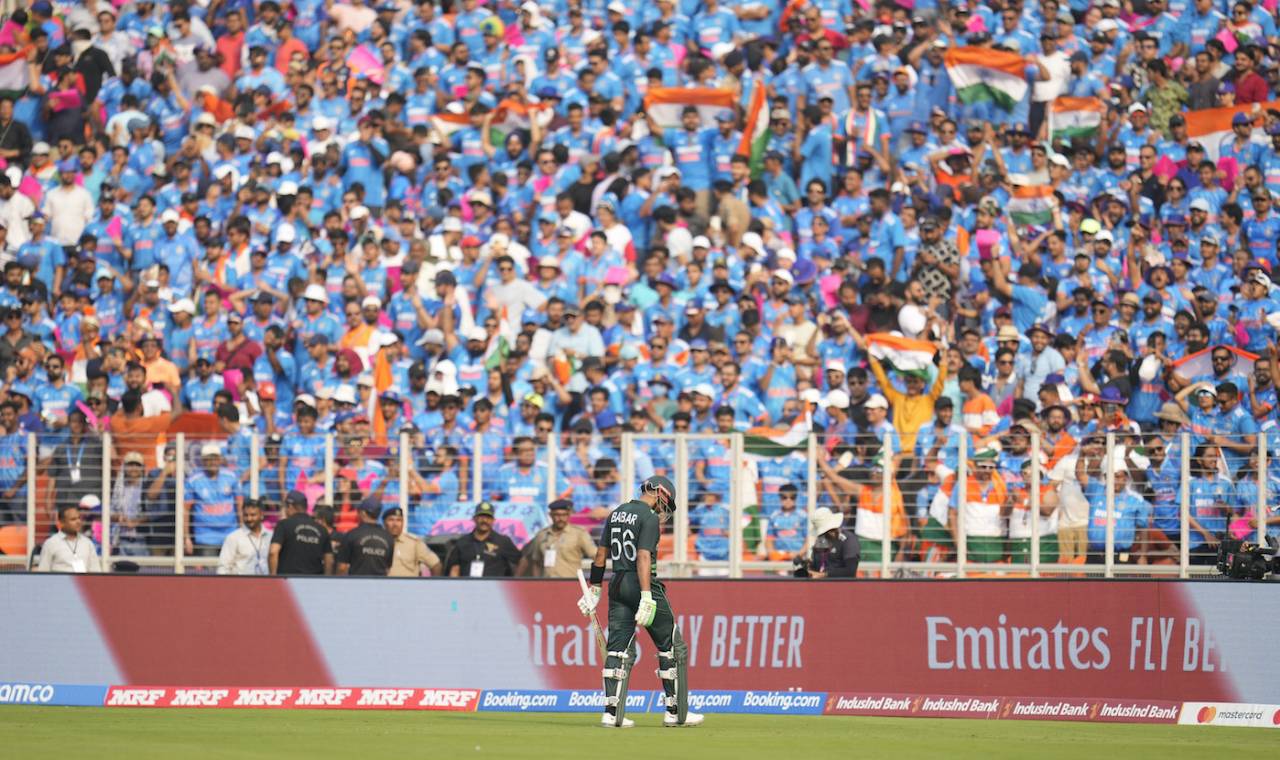There is noise. And, then there is noise as force: pure, purposeful, and meant to deliver a punch.
Through the years of the IPL, and the multitude of T20 leagues, we have grown accustomed to the former kind. It's constant, blaring, engineered and soulless. Noise for the sake of noise: you must make plenty of it because it's being demanded, and it's supposed to be part of the entertainment bundle you signed up for.
You scream at fours and sixes, you flail about between balls and overs, you sway sideways, flash your phone lights, become part of Mexican waves: you are part of the performance, you allow yourself to be conducted. You know it, and the players know it. They block it out as white noise.
And then you get to places and matches where the crowds know what they are doing.
The Narendra Modi Stadium is built to be imposing, a nod to muscular exhibitionism and a symbol of Indian cricket's pole position in the sport. It beats the Melbourne Cricket Ground by at least 20,000 seats, and though not as tall and colosseum-like as the MCG, its vastness makes it feel as gladiatorial. And it's safe to say that cricket has never seen as many blue jerseys at a venue as it did today.
Every inch of this stadium was packed for
the last IPL final despite it being pushed by a day on account of rain but never had this ground hosted an India match of this magnitude. The previous ODI games here were played during the Covid era, and the Test match during Border-Gavaskar Trophy, despite the pomp of two prime ministers making a grandstand appearance, was thinly attended. So here it was, the real deal, the day this stadium you hope was built for, to be bathed in cacophonous blue. And when the moments came, it produced the noise so quintessentially organic to the Indian cricket experience.
It began in the middle of that phase when Jasprit Bumrah and Kuldeep Yadav, whose originality and wicket-taking threat form the heart of this versatile Indian bowling machine, were hastening a
Pakistani meltdown from a cushy 155 for 2. Stadium regulars would know the drill. The routine begins at the start of the bowler's run-up with a collective swoosh and gathers decibels in sync with the bowler - in this case Bumrah - running in, reaching peak volume at the point of delivery. It's rhythmic, full of intent, and if you are the batter, full of menace.
This is a case of fans recognising a moment and becoming one with it. Players recognise this too, and they feel the energy and feed off it.
No Pakistani cricketer would have played before a crowd as large, and as vociferously partisan, as this and though international players are internally wired to steel themselves against it, for them not to sense this air of intimidation would have been impossible. They would have expected it and prepared for it, but having never played India in India, and having played all their World Cup games against other teams in friendly Hyderabad, an experience such as this needs to be lived to be learnt. As forgettable as their performance was at this ground, the experience might remain unforgettable.
It didn't have to be this one-sided though. The last time
these two teams met at an ICC event, the crowd was nearly as large. And Virat Kohli's biomechanics-defying six off Haris Rauf, followed by another to tilt a near-impossible equation towards India, turned the match into a humdinger. But though, like everywhere else, the Indian fans easily outnumbered the Pakistanis, there was at least a contest in the stands. And from all accounts, the sloganeering, baiting and banter was good-natured, and it spilt over to the streets and pubs in the evening.
I have watched India and Pakistan play in Lahore, Bengaluru, Adelaide, Centurion, Johannesburg, and now Ahmedabad, and never has a cricket ground felt so hopelessly lacking in something so essential: one group of fans. A small group of Pakistani journalists have finally made it to the tournament, after
their long wait for a visa to India ended just in time for this game, but no fans have managed to cross the border yet. And there is no word yet on whether they will be able to.
Mickey Arthur, the Pakistan team director, didn't mince his words after the game. "It didn't seem like an ICC event tonight, let's be brutally honest," he said at the press conference. "It seemed like a bilateral series, a BCCI event. I didn't hear
'Dil Dil Pakistan' coming through the microphones tonight. Yes, that [the possibility of being intimidated by a partisan crowd] does play a role, but I'm not going to use that as an excuse. For us, it was about living the moment, it was about the next ball, and it was about how we're going to combat the Indian players."
Pakistan, in keeping with their performance against India in the World Cup - 0-8 with this defeat - were abysmal once again. But despite that, this match was this tournament's biggest draw. And Arthur was spot on. The World Cup is billed, rightfully, as the biggest festival of cricket, and it will continue to feel like a travesty, and an act of neglect, if the organisers fail to ensure the participation of the whole cricket world in it, particularly those who give it colour and life.

